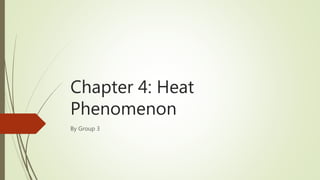Chapter 4 discusses the first law of thermodynamics, focusing on energy conservation and transforming energy forms through thermal and mechanical interactions. It also covers specific heat, calorimetry, latent heat, and methods of heat transfer, explaining the principles guiding these phenomena. Additionally, the chapter introduces concepts of entropy as related to thermodynamic processes and energy availability.


![Two General Ways of Changing Energy
Thermal Interaction ( through conduction, convection, and radiation )
Heat absorbed by the system → ∆Q > 0
Heat given off by the system → ∆Q < 0
Mechanical Interaction
∆W > 0 → work done [by] the system
∆W < 0 → work done [on] the system](https://image.slidesharecdn.com/heatpenomenon-180724154502/85/Heat-phenomenon-3-320.jpg)




![Corresponding change in internal energy is
∆E = ∆Q - ∆W
Where
∆Q > 0 for heat absorbed
∆Q < 0 for heat given off
∆W > 0 for work done [by] the system
∆W < 0 for work done [on] the system](https://image.slidesharecdn.com/heatpenomenon-180724154502/85/Heat-phenomenon-8-320.jpg)

























![ An aluminum (Al) container has a mass of 50 g and holds 200 g of water at
20°C. Find the final temperature of the resulting mixture when a mass of 500 g of
Lead (Pb) at 95°C is placed in the water ( cAl=0.22 cal/g-°C; cPb= 0.031 cal/g-°C).
Solution:
Heat lost by Lead = Heat gained by the aluminum and water
QPb = QAl + Qwater
(mcΔT)Pb = (mcΔT)Al + (mcΔT)water
Substituting the given values and solving for the final temperature
Tmix of the mixture, We get
500(0.031)(95 – Tmix) = [50(0.22) + 200(1.0)][Tmix -20]
Tmix = 25.13°C](https://image.slidesharecdn.com/heatpenomenon-180724154502/85/Heat-phenomenon-34-320.jpg)





















